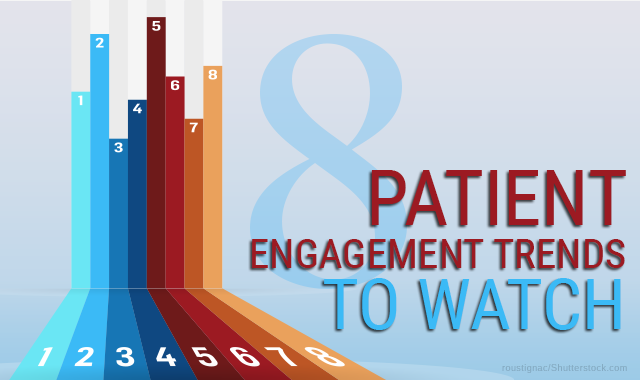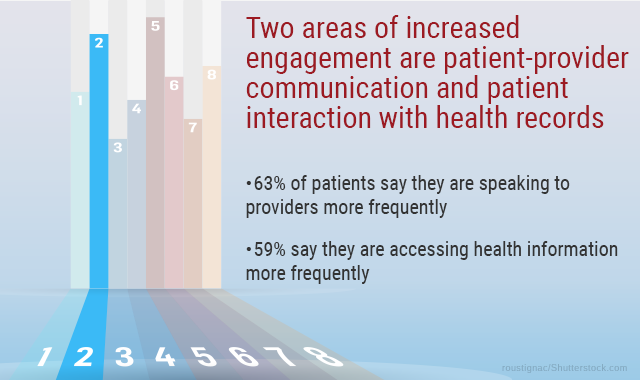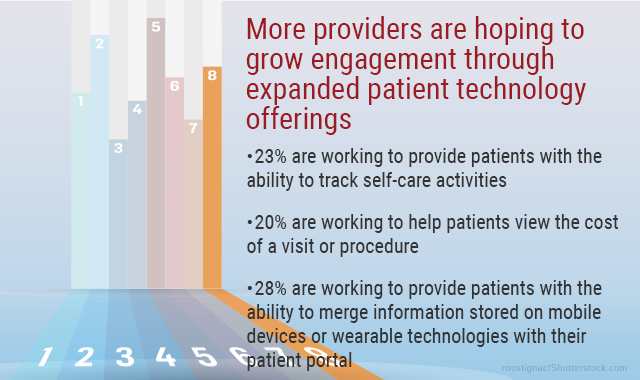Eight patient engagement trends to watch
Boosting patient engagement is critical as the industry shifts toward value-based payments. For payers and providers, higher engagement increases the likelihood of positive outcomes at lower costs.


Boosting patient engagement is critical as the industry shifts toward value-based payments. For payers and providers, higher engagement increases the likelihood of positive outcomes at lower costs.
To determine where the industry stands when it comes to patient engagement, and what providers are doing to increase it, CDW Healthcare recently surveyed 200 patients and 200 providers. The results provide a glimpse at some of the biggest engagement challenges the industry faces, and insight into some of the key drivers that could increase engagement.
Bob Rossi, vice president, CDW Healthcare, says the research is unique because providers and patients were surveyed to gain a better understanding of how the two sides view patient engagement as healthcare moves toward a value-based payments model.
“The research highlights beneficial insights that can help the industry understand common ground and differences in perspectives to transform the patient experience, improve outcomes and support fiscal stability, as well as technology’s role in advancing patient involvement to improve outcomes and help reduce costs,” says Rossi.


Providers, as always, are concerned about patient health and outcomes. They are also facing new financial pressure and incentives, such as pay-for-performance and meaningful use requirements, says Rossi. On the patient side, new technologies are emerging-such as wearables-that provide patients with immediate feedback on activity levels and key health metrics.
“At the same time, providers are also extending new technologies to their patients, through portals and other online access to health information, which help patients more easily and consistently engage with their health.”


Communication is a fundamental aspect of expanding engagement, as the survey shows, and technology solutions-such as patient portals, clinical mobility and collaboration-play a vital role in helping patients interact with providers and their own healthcare information more frequently, says Rossi.
“These solutions help to improve communication between providers and patients, deliver relevant and timely data to enable more informed decisions, simplify access to health information and ensure security of protected health information,” says Rossi. “We do expect this frequent interaction to grow, as our survey found that both patients and providers welcome expanded access to health information via online channels, which in turn, helps them engage with their care more frequently.”


It’s no secret that providers and their staffs are busier than ever, making meaningful communication with patients an even greater challenge, says Rossi. “Our own research is supported by a 2013 Health Dialog study, which found patients that receive enhanced decision-making support have lower overall medical costs and fewer hospital readmissions. Technology is essential to optimizing patient communication within and beyond the walls of the clinic or hospital, making communication easier, more efficient and more meaningful. This increased communication promotes more active involvement, which leads to better patient outcomes and care delivery.”


A combination of factors are at work, which will drive the need for greater patient engagement in the next few years, says Rossi, noting that financial factors- both incentives and pressures-play a growing role for providers, in addition to their understanding of the role of increased patient engagement in improving one’s health.
“Those influences, combined with new technologies that enable patients and providers to communicate and stay connected in ways they couldn’t before, will also continue to be a key factor in boosting patient engagement in the next few years as we become an increasingly connected community,” he says.


“There could be several reasons for the disconnect between providers and patients when it comes to prioritizing patient engagement, including the need to expand communication about new ways of engaging, such as via patient portals, as well as simplifying access to health information via online or mobile channels,” says Rossi.


Rossi points to new research from Accenture, which found that in the past two years, U.S. consumers who used wearables and mobile applications for managing their health doubled. “We expect these technologies will continue to play a large role as they provide a platform for patients to easily interact with their health information in real time,” he says. “Research from Deloitte also supports this, showing that a connected health technology strategy, which includes wearables and mobile applications, among others, may help to reduce costs and improve patient outcomes. As patient adoption of these technologies continues to take off, we expect to see wearables and connected health technologies contribute to expanding patient engagement.”


Challenges with interoperability and integration make increasing patient engagement harder, specifically when it comes to unlocking the full potential of the health information exchange to enable more informed decisions, and in turn, improved patient outcomes, says Rossi. “However, we are seeing moves to help public policy catch up to health IT innovation, as the Office of the National Coordinator for Health Information Technology’s Federal Health IT Strategic Plan 2015-2020 and
Nationwide Interoperability Roadmapare poised to help the industry overcome interoperability and integration challenges.”


“Solutions for clinical mobility, collaboration, patient/staff communication and patient portals, to name just a few, will be crucial tools for helping the industry support expanded patient engagement,” says Rossi. “Mobile devices and wearable technologies also offer patients quick and easy access to their personal health information as well as help them track their activities, and the growing effort to merge that information with a provider’s patient portal will only spur interaction between providers and patients.”
In the Scope of Virtual Health and the Future of “Website” Manner, Per Ateev Mehrotra
August 10th 2023Briana Contreras, an editor of Managed Healthcare Executive, had the pleasure of catching up with MHE Editorial Advisory Board Member, Ateev Mehrotra, MD, MPH, who is a professor of healthcare policy at Harvard Medical School and an Associate Professor of Medicine and Hospitalist at Beth Israel Deaconess Medical Center.
Listen
Extending the Capabilities of the EHR Through Automation
August 2nd 2023Welcome back to another episode of "Tuning In to the C-Suite," where Briana Contreras, an editor of Managed Healthcare Executive, had the pleasure of chatting with Cindy Gaines, chief clinical transformation officer at Lumeon.
Listen